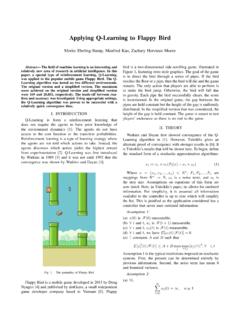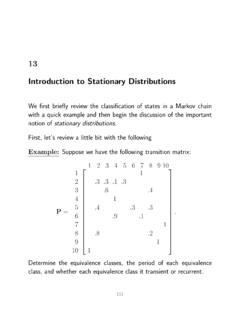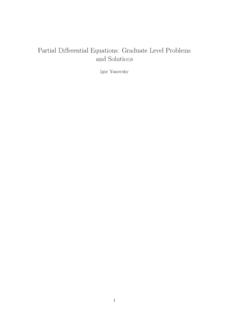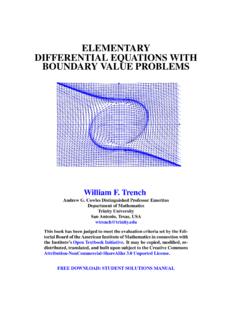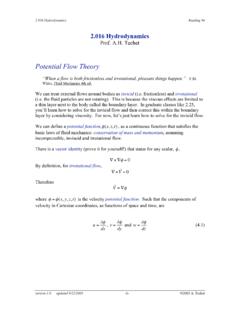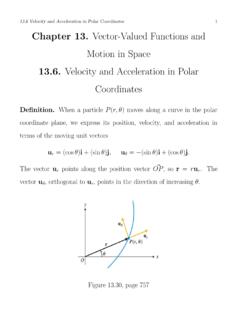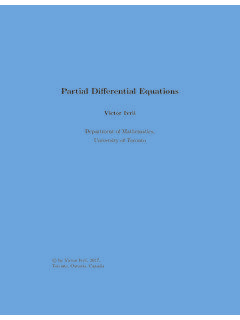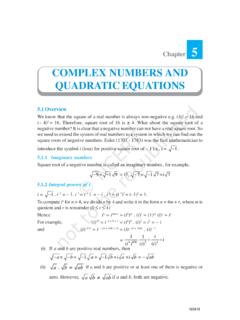Transcription of Introduction to Differential Equations - Queen's U
1 Introduction to DifferentialEquations(For smart kids)Andrew D. LewisThis version: 2017/07/172iPrefaceThis book is intended to be suggest a revision of the way in which the firstcourse in Differential Equations is delivered to students, normally in their secondyear of university. This course has traditionally grown as an offshoot of the calculuscourses taught in the first year, where students often learn some techniques andtricks for solving specific problems, , for computing specific derivatives andintegrals. This is not an entirely unreasonable thing to do, since it is difficult toimagine being able to practice mathematics without being able to handle calculuswith some of the basic special functions one encounters in a first ,a first calculus course often comes complete with many insights into the meaningof, and uses of, differentiation and integration. However, this techniques andtricks method becomes less valuable for ordinary Differential Equations .
2 The factis that there are very few Differential Equations that can be solved, and those thatcan be solved only succumb after quite a lot of , while I do believe it isessential to be able to solve a number of Differential Equations by inspection andI expect students taking the course for which this is the text to be able to dothis the proliferation of computer packages to carry out efficiently and effectivelythe tedious computations typically learnt in a Differential Equations course makesone reconsider why we teach students multiple ways to solve the same small setof Differential Equations . This text is the result of my own reconsideration of thetraditional first course in Differential an instructor, the question becomes, If I do not teach all of the usualtechniques and tricks for solving Differential Equations , what do I replace it with? My choices for answers to this question are the sure students know that Differential Equations arise naturally in a wide varietyof fields, including the sciences, engineering, and the social is done bystarting the text with a long list of examples of models involving differentialequations.
3 For some of these, we are able to provide a pretty complete rationalefor where the Equations come from, and in some cases we can make predictionsbased on our human experience about how solutions of these Differential equa-tions may behave. However, in some cases we are merely able to describe inplain English what the Equations represent, and then just write them down. But,1 That being said, the following conversation happens in most courses I teach:Me:Oh no, an integral! Class, how do we solve integrals?Class:Google! Wolfram Alpha!Me:Correct!2 And so we have..Me:Oh no, a Differential equation! Class, how do we solve Differential Equations ?Class: Google! Wolfram Alpha!Me:Correct!iiat the end of the day, we produce a long list of Differential Equations of variouskinds. Thus we do not restrict ourselves to modelling involving simple dif-ferential Equations , but also provide some impossibly complicated differentialequations so that the subject is not this leads to the following sure students know what a Differential Differential equationis normally written as just that: an equation.
4 The problem with this is thatequations are not really mathematically useful. When one writes down anequation with an unknown, this is something to be solved, not something to beunderstood. Thus we demur from just writing Differential Equations , and definethem initially as maps whose properties can be enumerated and treating Differential Equations in this way, it is seen that there is a commonstarting point foralldifferential Equations , and that the ones that we learn howto solve are very special and degenerate in some how to use a computer when working with Differential are so few Differential Equations that can be solved analytically, and alsobecause the analytical solution procedures are often extremely tedious to apply,one may wish to have at hand computer methods for working with differentialequations. Computer packages come in two basic flavours, which give, alongwith some examples of algebra systems:A computer algebra system can typically find an-alytic solutions to Differential Equations , when these can be easily example, any decent computer algebra system can solve any differen-tial equation we solve using the methods in this book.
5 Some examples ofcommonly-used computer algebra systems are:(a)Maple : (b)Mathematica : (c)Maxima : (d)SageMath : computation packages:Even if one cannot use a computer alge-bra system to obtain analytic solutions to Differential Equations , one canoften use algorithms that approximate Differential Equations and producenumerical solutions. This is very often the only thing one is interested inin hardcore applications of Differential Equations , even in cases where ana-lytical solutions are possible. Some examples of commonly used numericalcomputation packages are:(a)Maple : (b)Mathematica : (c)Matlab : (d)Octave : (e)Scilab : can be seen, it is often (but not always) the case that a computer algebrasystem offers the facility to do numerical computations with differentialequations, along with that for doing symbolic above list is by no means an exhaustive accounting of what is available,and for a more complete (but still not complete) list, please visit the appropriateWikipedia pages: wish to emphasise that we do not go deeplyat allinto numerical analysisin this text.
6 Indeed, we use computer packages as a tool, and one must beaware as when using any tool of its limitations. However, from a pragmaticpoint of view, computer packages in the present day are so sophisticated thatone typically must go very deeply to see why they might break, and to do so iswell beyond our present the character of solutions, rather than just producing their there is something gratifying in being able to go through along involved process, and arrive at a correct solution to a Differential equation,it is far more interesting and useful to be able to understand (a) why the solutionprocess works and (b) what is the character of the solution one obtained. Thus,while we do consider some of the standard methods for solving differentialequations, we do not either start or stop transform methods for Differential Equations , since these are very , we do not wish to introduce transform methods as providing analgorithmic procedure for solving (in practice, only very simple) differentialequations.
7 What we wish to do is illustrate, in as general a way as possiblein an introductory text, theraison d etrefor transform methods, which is thatthey turn Differential Equations into algebraic Equations , maybe only partiallyso. Thus we introduce a variety of transforms used in a variety of is Version 1 of these notes, so please indicate errors or suggestions D. LewisKingston, Ontario, CanadaivTable of Contents1 What are Differential Equations ? do Differential Equations arise in mathematical modelling? .. systems .. motion of a simple pendulum .. s equation .. circuits .. systems .. models .. models .. Lagrange Equations .. s Equations .. The Navier Stokes Equations .. Heat flow due to temperature gradients .. Waves in a taut string .. The potential equation in electromagnetism and fluid me-chanics .. Einstein s field Equations .
8 The Schr odinger equation .. The Black Scholes equation .. Summary .. Notes .. mathematical background and notation required to read this text mathematical notation .. numbers .. arithmetic .. representation .. of complex numbers .. algebra .. spaces and subspaces .. independence and bases .. maps .. maps and inhomogeneous linear Equations . and eigenvectors .. and external direct sums .. maps .. analysis .. of Differential Equations .. in Differential Equations .. Equations and solutions .. Differential Equations .. ordinary Differential Equations .. ordinary Differential Equations .. Differential Equations .. partial Differential Equations .. and quasilinear partial Differential Equations , hyperbolic, and parabolic second-orderlinear partial Differential Equations .
9 To think about Differential Equations .. question of existence and uniqueness of solutions .. and uniqueness of solutions for ordinary differen-tial Equations .. motivating existence and uniqueness ofsolutions for ordinary Differential Equations .. existence and uniqueness theorems forordinary Differential Equations .. for ordinary Differential Equations .. and uniqueness of solutions for partial differentialequations.. NOT!! .. 1082 Scalar ordinary Differential first-order scalar Equations .. linear homogeneous ordinary Differential Equations .. with time-varying coefficients .. and their properties .. Wronskian, and its properties and uses .. with constant coefficients .. of scalar linear ordinary differen-tial Equations .. operator calculus .. of solutions .. examples .. linear inhomogeneous ordinary Differential Equations .
10 With time-varying coefficients .. and their properties .. a particular solution using the Wronskian . Green s function .. with constant coefficients .. method of undetermined coefficients .. examples .. a computer to work with scalar ordinary Differential basic idea of numerically solving Differential Equations . Mathematica to obtain analytical and/or numericalsolutions .. Matlab to obtain numerical solutions .. 1763 Systems of ordinary Differential .. along solutions .. about equilibria .. flow of the linearisation .. we re at it: ordinary Differential Equations of classCm. of linear homogeneous ordinary Differential Equations .. with general vector spaces .. with time-varying coefficients .. and their properties .. state transition map .. Peano Baker series .. adjoint equation .. with constant coefficients .. subspaces associated with eigenvalues.

